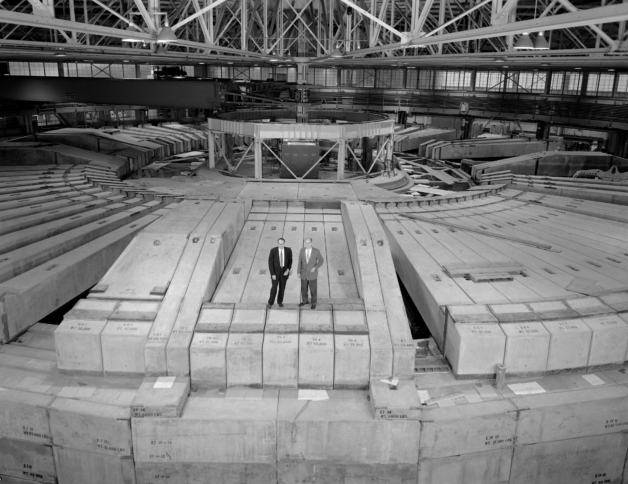
A 1963 photo of the Bevatron with Berkeley Lab Director Edwin McMillan (left) and Bevatron Group Leader Edwin Lofgren. (credit: Berkeley Lab)
The site of the former Bevatron, a particle accelerator at the Department of Energy’s Lawrence Berkeley National Laboratory (Berkeley Lab) that operated from 1954 to 1993, has been designated a historic site by the American Physical Society (APS) for its exemplary contributions to physics, including the discovery of the antiproton.
“The Bevatron site designation is a symbol of what teams of people from many fields of science, engineering, and operations can do when they work together across disciplinary boundaries to solve a problem — in this case unlocking the mysteries of the atom,” said Berkeley Lab Director Mike Witherell. “It demonstrated the kind of big team science that evolved into the national laboratory system and led to many more discoveries and solutions to humankind’s most challenging problems over the decades. We are honored to have this important symbol of scientific history recognized in this way.”
The APS news release announcing the historical designation adds:
For nearly 40 years, the Bevatron was among the largest and highest-energy particle accelerators in the world. It was designed to accelerate protons to billions of electron volts. Just one year after its completion in 1954, Berkeley Lab and University of California, Berkeley physicists Emilio Segrè and Owen Chamberlain used the facility to confirm the existence of antimatter by producing antiprotons. That discovery, which was awarded the 1959 Nobel Prize in Physics, was a significant milestone in the new era of government-funded “Big Science.”
In the 1970s, the Bevatron was combined with the Super Heavy Ion Linear Accelerator to become the Bevalac, the predecessor to today’s Relativistic Heavy Ion Collider at Brookhaven National Laboratory and the Large Hadron Collider at CERN. The Bevatron/Bevalac ended its service in 1993 and was demolished between 2009 and 2012.
The former Bevatron site will be listed in the APS historic sites online directory, and Berkeley Lab will receive a plaque from APS with a citation that reads:
On this site in 1955, a year after completion of the Bevatron, Chamberlain, Segrè, Wiegand, and Ypsilantis reported the discovery of the anti-proton. In the 1960s bubble chambers here revealed many new particles, evidence for SU(3) symmetry, now known to be the sign of the three lightest quarks. Later, Ghiorso conceived and Grunder built the Bevalac by merging the Bevatron and the SuperHILAC into the world’s first relativistic heavy-ion accelerator. It accelerated ions from protons to uranium, launching high-energy heavy-ion physics and clinical radiotherapy with heavy-ion beams.
Berkeley Lab’s team science approach lives on where the Bevatron once stood. The site now houses the 80,000 square foot Integrative Genomics Building (IGB) – home to the DOE Joint Genome Institute (JGI), the DOE Systems Biology Knowledgebase (KBase), and the National Microbiome Data Collaborative (NMDC).
The designation comes as Berkeley Lab celebrates its 90th anniversary, which invites the Berkeley Lab community to celebrate the Lab’s past and imagine its future.
APS historic sites recognize places for their historical significance to the field of physics. More information about this initiative can be found here.
###
Founded in 1931 on the belief that the biggest scientific challenges are best addressed by teams, Lawrence Berkeley National Laboratory and its scientists have been recognized with 14 Nobel Prizes. Today, Berkeley Lab researchers develop sustainable energy and environmental solutions, create useful new materials, advance the frontiers of computing, and probe the mysteries of life, matter, and the universe. Scientists from around the world rely on the Lab’s facilities for their own discovery science. Berkeley Lab is a multiprogram national laboratory, managed by the University of California for the U.S. Department of Energy’s Office of Science.
DOE’s Office of Science is the single largest supporter of basic research in the physical sciences in the United States, and is working to address some of the most pressing challenges of our time. For more information, please visit energy.gov/science.
